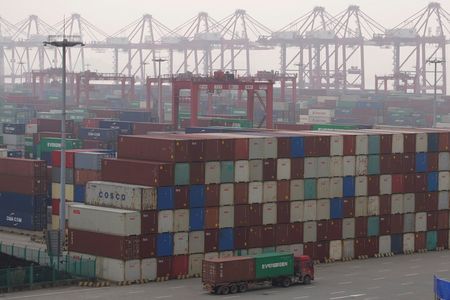By Ellen Zhang and Ryan Woo
BEIJING (Reuters) -China’s usual year-end export surge is in doubt as weak global demand dims a rare bright spot for the world’s second-biggest economy, already hurt by COVID-19 lockdowns, a frozen property sector and ebbing domestic consumption.
Exports fell unexpectedly in October for the first time since May 2020, and signs are grim for the November-December period when demand normally peaks as overseas clients place orders before China’s factories close for Lunar New Year holidays in January or February.
Exporters had already failed to get the typical pre-Christmas surge during the summer. Analysts expect global recession risks and China’s disruptive COVID curbs will further drag on exports in coming months, dashing hopes for an economic rebound this quarter.
“Pressure has never been huge like this,” said Qi Yong, a Shenzhen-based exporter selling electronics to Europe. Russia’s war in Ukraine has inhibited European spending for items like electronics that are not daily necessities, he said.
Qi was not sure of the scale of orders that overseas customers would place in December.
Jin Chaofeng’s Hangzhou-based company exporting outdoor rattan furniture would typically be ramping up production now. Instead, he has been cutting inventory after orders dived around 30% in the first week of November from a year earlier.
“I’m pessimistic about the overall exports in November and December,” Jin said. “For now, it seems the year-on-year drop in the two months combined will be at least 30% considering the high inflation, rate hikes and layoffs in the U.S.”
Demand from customers in some developed markets has also shifted from pandemic-driven goods, such as consumer electronics, to services including travel, as many COVID-hit countries reopened their borders.
‘CHRISTMAS DISAPPEARED’
“Weak export growth is a real problem for China because it has been the only strong component of what Beijing refers to as ‘high-quality’ growth, which is mainly growth driven by increases in domestic consumption, exports and business investment, with the last of these driven in turn by the first two,” said Michael Pettis, professor of finance at Peking University.
That means Beijing must either step up investment in infrastructure, which is likely to cause debt to surge, allow an unwanted rise in unemployment or boost payments to ordinary households, which so far it has been unable to do, Pettis said.
Outbound shipments, after peaking for the year in July, have been deteriorating by value, despite a falling Chinese currency, official data show. A closely watched private-sector survey focussing on small manufacturers shows export orders contracting since August.
Buyers usually book orders for Christmas and Black Friday around August, but weak demand already sapped any lift this period.
And things have only gotten worse.
Declines in China’s exports of toys accelerated to 17.9% on-year in October from 9.7% in September, clothing to 16.9% from 4.4% and home appliances to 25% from 19.8%, according to Reuters calculations based on customs data.
The slump is particularly evident in developed economies: shipments to the United States fell 12.6% in October by value and to the European Union by 9%.
In line with the export declines, freight rates from Shanghai port to the U.S. west coast, Europe and South America were down by 11.6% to 16% on Nov. 4 from a week earlier, according to the Shanghai Shipping Exchange.
Global inflation pressure had prompted some overseas buyers, concerned about further rises, to boost purchases from China in the middle of the year, earlier than usual, said Bruce Pang, chief economist at Jones Lang Lasalle.
“The traditional Christmas peak season has disappeared in 2022,” Pang said.
(Reporting by Ellen Zhang and Ryan Woo)

